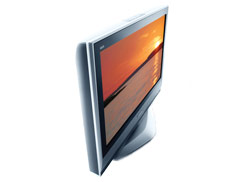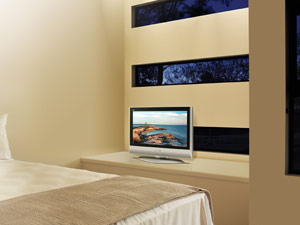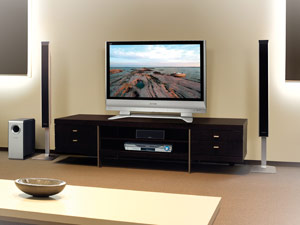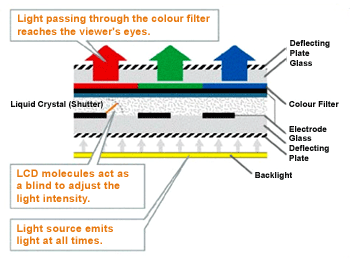LCD and Plasma TV Screen
The wonderful world of TV is somewhat confusing for most people. The concept of several new technologies evolving at roughly the same time to replace a single TV technology has dumbfounded many. We have been watching CRT based televisions for more than 50 years and now consumers are being bombarded by many new technologies including Plasma and LCD.
The obvious question for most people is: “Which one is the best?” The key point to recognize about TV technologies is they all excel under certain conditions. It is simply a matter of matching the right TV to the right application. For example, one obvious advantage with Plasma and LCD TVs is their ultra-thin design, (average depth of a VIERA television is about 10 cm), which makes them very versatile.
LCD

- Suitable for smaller screen sizes
- Perfect for a kitchen, bedroom, den or office
- Best for very bright lighting conditions
- Produces a brighter picture
- Offers higher contrast in bright rooms
|
Plasma

- Suitable for larger screen sizes
- Perfect for a family room or home theatre
- Best for normal home lighting conditions
- Delivers a faster response time
- Offers higher contrast in dark rooms
- Produces natural/vivid true-to-life colour
|
Questions to consider before purchasing an LCD/Plasma television
Which screen size is right for you?
To get the best performance from your new flat panel TV, you must consider 3 factors:
- Viewing Distance
- Screen Size
- Screen Resolution (EDTV or HDTV)
EDTV Panel:
The minimum viewing distance recommended for an EDTV panel or standard definition video source is 3x the diagonal screen size divided by 12.
For example, a 42” EDTV panel’s minimum viewing distance is 10’ 6”. (42” x 3 = 126”, 126 ÷ 12 = 10.6)
HDTV Panel:
The minimum viewing distance recommended for an HDTV panel and HDTV video signal is 2x the diagonal screen size.
For example, a 42” HDTV panel’s minimum viewing distance is 7’. (42” x 2 = 84”, 84 ÷ 12 = 7)
What will be the most common video signal? (Cable TV, HDTV or DVD Video)
Always try to provide your TV with the best signal. Better quality cables and a high-definition signal will offer the best picture performance possible.
What is your lighting environment? (Lots of sun, incandescent or fluorescent)
Plasma TVs perform best under incandescent or halogen lighting while LCD perform better under fluorescent lighting. Lots of sunlight will wash out any TV display but a good set of lined drapes will solve that problem.
Where will the TV be located? (Mounted on a wall, on a shelf or floor stand)
Both plasma and LCD TVs from Panasonic can be hung on a wall, using wall brackets specifically designed for this application. It is a good idea to consult an install technician to ensure proper support for the TV and to neatly hide the wires. Most VIERA Flat panel TVs come with a matching pedestal stand for placement on a credenza or in a wall unit. Matching floor stands are also available for select plasma models.

LCD TV Application |

Plasma TV Application |
LCD Technology
Panel Structure
 The material enclosed between the two glass plates is in a liquid crystal state. When voltage is applied, the LCD molecules change their direction, thus increasing or decreasing the amount of light they will pass. The material enclosed between the two glass plates is in a liquid crystal state. When voltage is applied, the LCD molecules change their direction, thus increasing or decreasing the amount of light they will pass.
Light Emitting Principal
Since the LCD itself does not emit light, a fluorescent light (backlight) is used to display images. Liquid crystals change the degree of transparency when the applied voltage is varied. The LCD TV draws on this unique characteristic of liquid crystals to vary the amount of light passing through the colour filters on the front surface in order to display images.
The LCD display can be thought of as a panel with more than 1 million miniature shutters opening and closing to display the images we see.
Plasma Technology
Panel Structure
 Each cell within the panel is coated with either red, green or blue fluorescent material (Phosphor), and covered with a front glass substrate that is embedded with display electrodes. The space between the two substrates is filled with a combination of rare gases. Each cell within the panel is coated with either red, green or blue fluorescent material (Phosphor), and covered with a front glass substrate that is embedded with display electrodes. The space between the two substrates is filled with a combination of rare gases.
Light Emitting Principal
The data electrodes initiate a pre-discharge, which triggers a discharge action with the display electrodes and causes a change of state in the Neon & Xenon gas mixture. This process produces ultraviolet light. When the ultraviolet light strikes the fluorescent materials, visible light is generated and this illuminates the screen surface.
The Plasma TV can be thought of as a panel whose entire surface is covered with tiny arrays of R, G, and B fluorescent lamps that turn on and off to display images.
Myths vs Reality
Power
 Independent studies have found that long-term power consumption is approximately the same (per square inch) for both types of TV (LCD & Plasma). Independent studies have found that long-term power consumption is approximately the same (per square inch) for both types of TV (LCD & Plasma).
Power consumption for a Plasma TV changes based on the image on-screen (higher for bright scenes and lower for dark scenes). LCD televisions use an almost constant amount of power because the backlights are always on, regardless of the video image.
Life Span and Burn In
 Uneven phosphor aging (otherwise known as “burn-in”) was a problem on early generation plasma displays (5-7 years ago) due to a shorter lifespan and use in industrial applications. Uneven phosphor aging (otherwise known as “burn-in”) was a problem on early generation plasma displays (5-7 years ago) due to a shorter lifespan and use in industrial applications.
The lifespan of the latest generation of plasma TVs has dramatically improved (60,000 hours) and an improvement in phosphors has almost eliminated the possibility of uneven phosphor aging when used in a consumer’s home.
Most people watch a variety of programming ranging from movies to news and reality TV. This variety in programming results in an evenly aged panel.
Plasma Gas
The gas in a plasma TV cannot be replaced, nor does it need to be replaced. The plasma TV panel is permanently sealed just like the old-fashioned tube TV and the light bulbs you use in your home.
LCD Backlights
The backlight bulbs in an LCD panel do not need to be replaced. They are an integrated part of the panel and are typically a non issue. The bulbs can last up to 60,000 hours, at 6 hours per day which works out to over 27 years. By that time, you’ll probably be looking for a new TV!
Conclusion
Now, which product is right for me? From a technology standpoint, LCD is better suited for smaller screen sizes and regular TV viewing because of its brighter image and higher perceived contrast in very bright rooms.
Plasma works best for living/family room or home theatre style applications because of its faster response time, natural colour reproduction and higher contrast in normal home lighting conditions. Fast action sports and movies with dark scenes always look best on a plasma television. It really is all about the application and not about the technology.
Contact Magen today at 416.658.5757 and our experts will help you.
| 
















 The material enclosed between the two glass plates is in a liquid crystal state. When voltage is applied, the LCD molecules change their direction, thus increasing or decreasing the amount of light they will pass.
The material enclosed between the two glass plates is in a liquid crystal state. When voltage is applied, the LCD molecules change their direction, thus increasing or decreasing the amount of light they will pass.  Each cell within the panel is coated with either red, green or blue fluorescent material (Phosphor), and covered with a front glass substrate that is embedded with display electrodes. The space between the two substrates is filled with a combination of rare gases.
Each cell within the panel is coated with either red, green or blue fluorescent material (Phosphor), and covered with a front glass substrate that is embedded with display electrodes. The space between the two substrates is filled with a combination of rare gases.  Independent studies have found that long-term power consumption is approximately the same (per square inch) for both types of TV (LCD & Plasma).
Independent studies have found that long-term power consumption is approximately the same (per square inch) for both types of TV (LCD & Plasma).  Uneven phosphor aging (otherwise known as “burn-in”) was a problem on early generation plasma displays (5-7 years ago) due to a shorter lifespan and use in industrial applications.
Uneven phosphor aging (otherwise known as “burn-in”) was a problem on early generation plasma displays (5-7 years ago) due to a shorter lifespan and use in industrial applications.